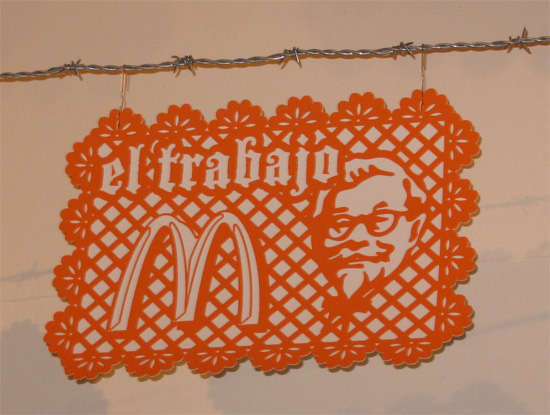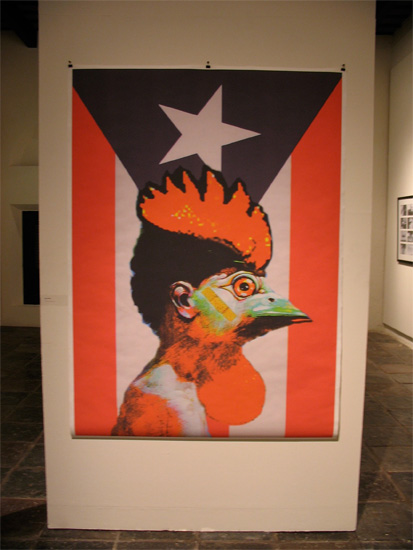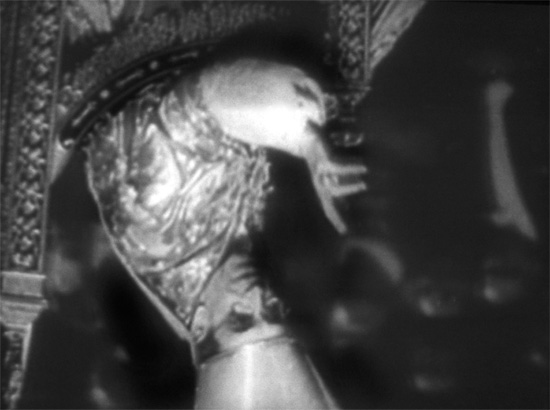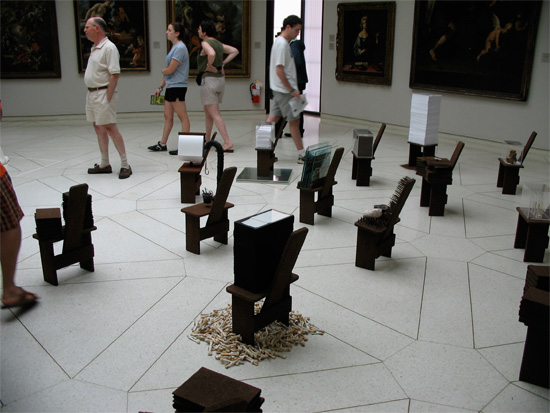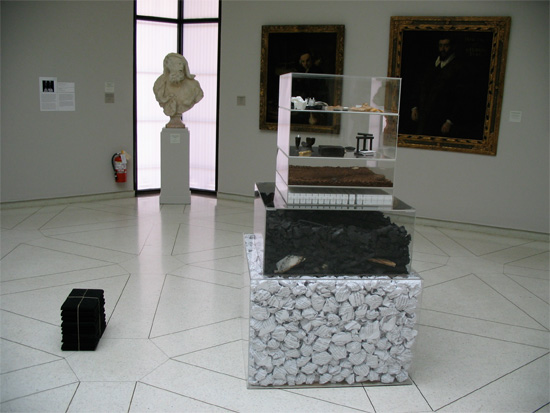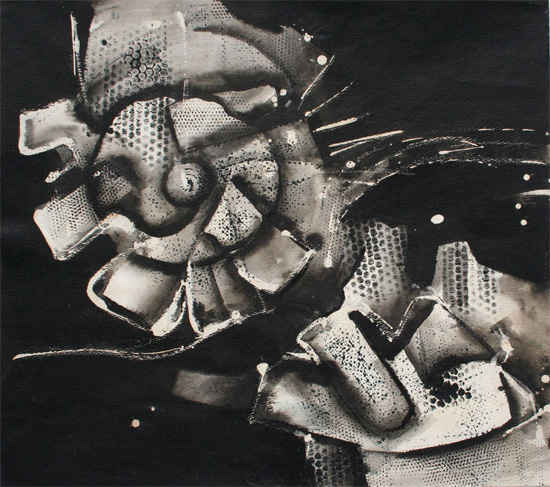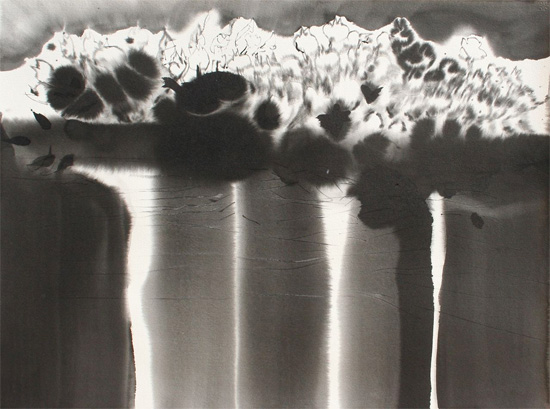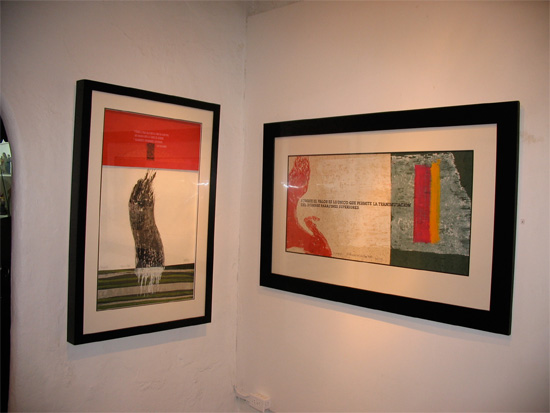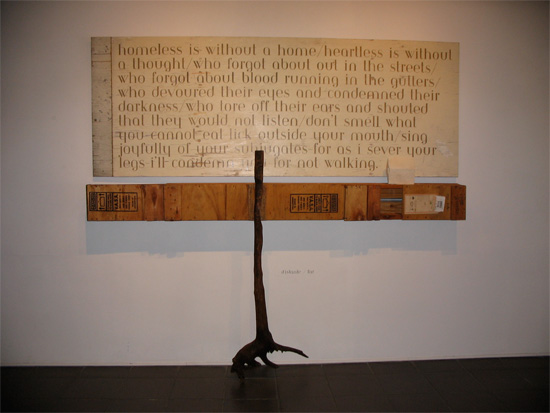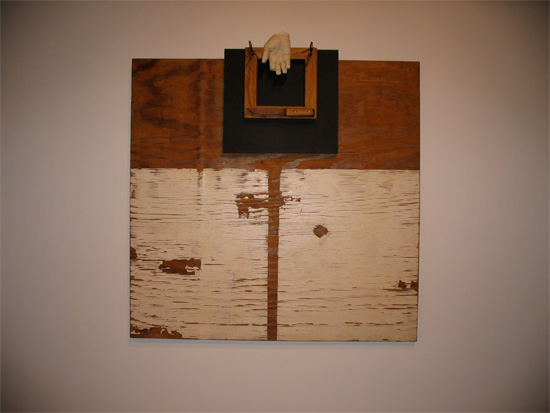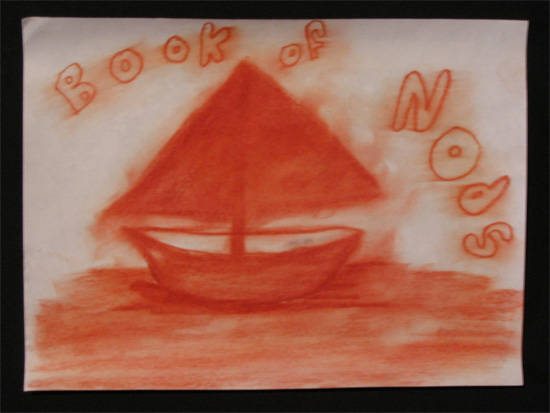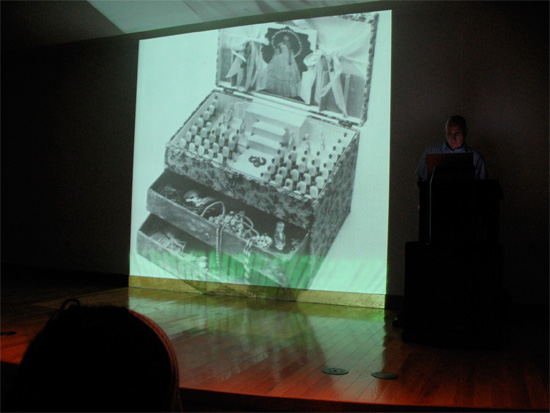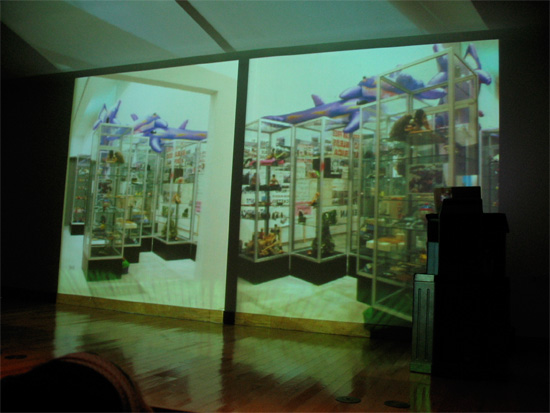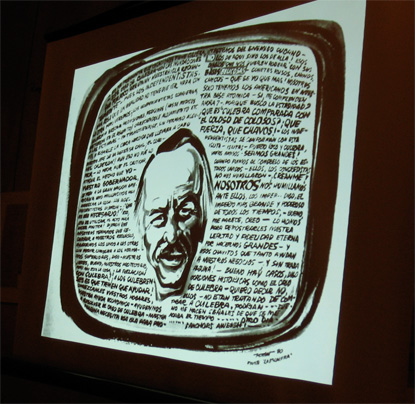|
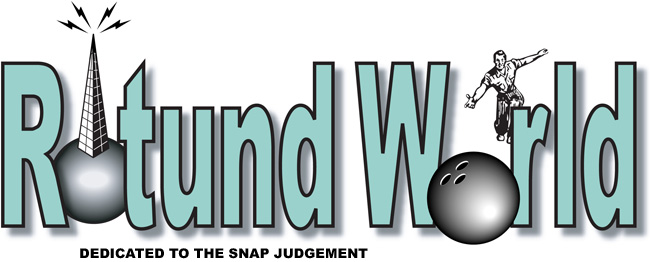
Off the Pig Power Structure!
Enough with the verbiage. The other night we went to a panel discussion in which artists were supposed to tell us what makes them tick. Certainly there was a word or two about that, one more intelligible than the other, but at moments we found ourselves holding our noses against malodorous gusts of wild generalizing and moldy incantations. The outbursts involved those evil capitalist tools, art museums, and their running-dog lackeys, the institutions’ curators, which apparently exist only to make artists suffer and pay with their very souls for entry into the gilded halls. Just to wipe their feet. And so on. Lord knows that the island’s museums are all beset by serious problems, owing largely to—duh!—the island’s chronically ailing economy and the political jealousies that inevitably seem to guide what passes for long-term vision. Let’s not even get into the easily-stirred passions. That does indeed mean that local contemporary artists are woefully under- represented in the institutions’ programming, and not everyone has a topnotch, up-to-date collection of what’s going on that is, let’s not forget to mention, worth having. But do curators really, as it was averred more than once, demand that artists submit to humiliating, soul-killing revisions of their work in order to participate in their snooty shows? Is there no “political” work to be seen in any institutional setting; is it all “safe as milk?” To be fair, not everyone on the panel talked in those terms. But please. Where have the others been? Certainly not to any museum lately, or La Puntilla at the Antiguo Arsenal de la Marina Española, where no less a bunch of government hacks than those lickspittles at el Instituto de Cultura Puertorriqueña (ICP) has been mounting one “political” show after another. If printmaker Garvin Sierra’s exhibition featuring a ram-horned George Bush and oil wells amidst M-16s and Army helicopters was not political commentary, we’re Emperor Maximilian of Mexico, the mad Carlotta, and twelve exotic dancers sporting rhinestone pasties and belly-button studs.
At this moment La Puntilla is in one of its glories, with a wide-ranging offering of the work of nuyorican Adal Maldonado—a flaunter of identity politics and master of excess if ever there was one—and a very nice, very comprehensive look at a pioneer of sound, film, and video art, Raphael Montañez Ortiz. Montañez Ortiz’s ideas may be as old as the hills by now, but his piano destruction performances are simply wack dada provocation and will be so forever, and his jittery, backwards-forwards-and-upside-down montages of 1950s cowboys-and-Indians classics, newsreels, and chickens in slaughter mode say more about the delusions of late capitalism than an entire roomful of sincere but perhaps not fully informed Mouseketeers nattering until Doomsday. (The first image above is Garvin Sierra’s version of papel picado, from his ICP sponsored exhibition at La Puntilla last May, Que Dios te lo pague. Below that, a work from the Maldonado exhibition Blueprints for a Nation. Next down, Montañez Ortiz’s The Pope’s Blessing, 1957-1958.) As you read this it may be too late to visit Maldonado’s show—it comes down October 15th—but you have until the 21st to catch Montañez Ortiz. Call 787-725-8320 or visit the ICP’s website for detailed information. We should mention that the curator of the latter exhibition, Beatriz Santiago Muñoz, was one of the panelists that night—she’s second from the right sitting at the table at the top of the page—though she was among those who offered a modulated view of artistic endeavor. We would not for a minute include her among the loose lipped. But let’s look at what island museums are actually doing. We honked on last episode about the latest installment of the permanent collection at San Juan’s Museo de Arte Contemporáneo (MAC), which includes a whole roomful of fine work by eighties- and nineties-generation Cuban artists—all whizes of art collectivism and social action during some time in their careers—including a photograph showing the amazingly anti-market ephemera of Ana Mendieta and some truly scary moments in video by Tania Bruguera. Santiago Munoz’s own entry in the larger exhibition, Archivo from 2001, is political in the smartest sense. At Museo de las Américas, a doorway away from Antonio Martorell’s inadvertently melancholy Martorell: DF, Museo de Arte de Caguas is collaborating in a tribute to Cagueño Carlos Osorio, in which you see numerous explicitly political works, from the dancing Uncle Sam calaveras of Carlos Fajardo to Quintín Rivera Toro’s scary photo self-portrait of the artist as consumerism’s willing soldier. Even a perfunctory glance at the present hanging of the collection at Museo de Arte de Puerto Rico (MAPR) belies the facile notion that museums are invariably the art world’s woolly mammoths. Whatever else MAPR suffers from, we cannot think of another place in the city where can you walk in off the street and sidle up to one of Pepón Osorio’s gaudy, room-sized boricuafests, just down the hall from a painting by Carlos Dávila Rinaldi which actually declares, “Gringomatic: nobody can remove that plantain stain.” Where besides MAPR is there a life-size representation of two horses unmistakably in full hump, compliments of the febrile brainwaves of Charles Juhász-Alvarado? Politics and provocation are where you find them, of course, and personally we think that a number of works in this collection are subversive to one degree or another, formally if not narratively, and although we wish it had the resources and the will to keep up with the times, we would never attribute to the organization a concerted effort to shut deserving contemporary artists out of its crypts and crannies. Walk down MAPR’s halls to the big sala by Ada Bobonis’s installation Estados sensibles— reviewed by us a couple of episodes ago—and visit the exhibition of early- to mid-twentieth century Spanish drawings. Is the room devoid of bite? Hardly.
Even that musty crown jewel of island museums, Museo de Arte de Ponce (MAP)— where, it must be confessed whenever we invoke the name, the beloved of one of our number labors in a key position, be warned, you rooters out of corrupt journalistic practices—has the jaunty air of incitement stirring its still and chilly Old World chambers. Victor Vázquez willingly installed, with no trouble at all from the mostly respectful staff, several of his conceptually nuanced, nails-in-flesh, bone-fragments-and-mysterious-texts works among the relatively tranquil European classics. Meanwhile, downstairs the museum has an ample selection of Rodin works from Museo Soumaya in Mexico City, and we all know that Rodin pretty much made the art establishment of his day shit its pants. Rodin plays Ponce until October 28. Vázquez’s Diálogos is there until November 4. We suggest you go to the needlessly busy museum website to get the lowdown on visiting hours, and you might want to make use of the phone number to get directions and other crucial data: 787-848-0505. Believe you us, it’s a long way to Ponce. (Shown above are two of the eight or so Vázquez works in Diálogos.) Speaking of MAP and malodorousness, we haven’t launched a buzz bomb in the general direction of El Güevo Día lately, nor have we invoked the name of the daily’s culture czar, Mario Alegre Barrios. But we’ve noticed that recently there has been a marked increase in the number of articles His Highness himself has penned about MAP exhibitions —or his minions have written them, two or three page spreads about Rodin and MAP holdings traveling to Monterrey, Mexico, though nothing yet, strangely, about the amazing Vázquez exhibition—and it got us wondering again about the paper’s insistence on not hiring an art critic because of supposed conflicts of interest. Alegre Barrios has argued on behalf of the paper, as we noted here, that no island writers are free of conflicts of interest, and therefore they’re unemployable by the paper. “These aspects are not negotiable in any way for El Nuevo Día . . . ” he puntualizó. We do not begrudge MAP a syllable of coverage—we wish that every deserving exhibition got doted on as much—but the fact remains that the Ferrés, the family who owns the newspaper, Alegre Barrios’s very bosses, are the same folks who founded and run the museum about which he’s writing. “Conflict of interest” is a slippery notion at best, but there could be no more universally accepted a definition of it than that writing about family constitutes one. So, if it’s such a big deal in the paper’s refusal to hire a full-time art critic, why is it so conveniently overlooked in current practice? Just a Rotund what the hay. Very well. We’re now going to put our money where are mouths are. We spoke of verbiage, we spoke of cutting it out. So what follows is a simple listing of what’s gotten our attention lately, with a minimum of editorializing. You know that just by being here, what follows registered more in the pleasure centers of our brains than in our hyperactive, way overdeveloped critical circuitry. In fact, the island art world seems to be at full boil, with no signs of simmering down any time soon. Before you know it, it will be time for CIRCA. Alas, we had our first CIRCA sighting just yesterday, a little item in El Güevo Día. It’s as disheartening as seeing the Christmas decorations going up at Plaza las Americas, “El Enemigo de Todos,” as Quintín Rivera Toro so aptly put it in La Muestra Nacional. But already we digress:
First of all, a tip o’ the Rotund hat to the too-rarely seen Carmelo Fontánez, who recently opened a wide-ranging drawing show at Primer Piso Gallery in Viejo San Juan. The first exhibition we saw after arriving in Puerto Rico two-and-a-half years ago was a big display at MAC of Fontánez’s marvelous little glass-sided boxes; part sculpture, part drawing, plays on the ideas and physics of drawing which contain actual carved pencils and graphite dust. His Primer Piso exhibition extends over four decades and shows him to be a first-rate draughtsman with an ever-evolving but always intimate connection to the landscape. The first work above is Cósmico from 1968, ink and wax on paper, 16" x 18". The other work is among the newest in the show, Reflejos, 2003, ink on paper, 22" x 29.5", and splendid. Images compliments of the gallery. Thanks, guys. Primer Piso Gallery is located at San José #53. You’ll have to call 787-722-4370 and speak to Michael or Fabian to find out how long the show lasts and when you can visit the gallery.
While you’re in the neighborhood, do yourself a favor and visit Galería Botello, whose contemporary art programming has been on the upswing lately. Botello has new woodcut and mixed-media works by Jorge Sierra, in an exhibition called La palabra como arma la palabra como alma. As you might expect with such a title, the prints all have prominent quotes and lengthier bits of text, often by Latin American figures such as Luis Palés Matos, César Vallejo, and Pablo Neruda. Ché is there, and so is that great Hispanic, Gandhi. Supple, colorful works which often rise above the literal-mindedness the words imbue them with. Botello is located down the hill from Primero Piso and over a block, at Del Cristo 208. Hours are Monday to Saturday, 10 a.m. to 6 p.m. The gallery has a very good, easily navigable website. Don’t we all? As usual, the photograph above has nasty reflections in the works’ glass, but friends, we’re not apologizing anymore for that because that’s exactly what you see when you visit the gallery.
We neglected to mention in our coverage of the Cuenca Biennial that Nestor Otero was part of the Puerto Rican delegation, along with Nayda Collazo-Llorens and Migdalia Barens-Vera. His installation was not among the ones we were eager to talk about, but we nevertheless should have noted his presence in Ecuador since it was newsworthy and not an unimportant milestone for the local contemporary scene. The entire delegation will be showing what they took to the Andes at Galería Raíces in December, and meanwhile Otero has an individual exhibition there at the moment, observaciones. The exhibition consists of several good-sized mixed media wall works as well as a number of small collages and drawings, and they show the artist as technically curious—his found-object arrangements are solidly, smartly built, with a great deal of there there—and poetically minded. He occasionally incorporates original texts, and these push the works in the direction of broadly conceived artist’s books. The simplest things appealed to us the most, like the two large digital prints, each with a discreet line of type, which demonstrate how ably Otero bridges abstraction and representation, formalist play and narrative invention, soul-deep disquiet and the cool argument. Galería Raíces is the decades-old labor of love of Carlos Rivera. It’s located in Santurce near MAPR at Avenida De Diego 316. It would be a good idea to phone Raíces at 787-733-8909 since Rivera does not keep the most regular hours. The front windows are ample, however, and even if the gallery’s closed you can get a glimpse of Otero’s work. The first work above is titled distante, and it’s mixed media, made in 2007. The second one we believe to be called en blanco, likewise mixed media and also created this year. We do not presently have the works’ dimensions. They’re bigger than a breadbox.
Once again we recommend a visit to Galería Comercial and some thoughtful time with I could be happy in infinity, the show of paintings and drawings by Fernando Pintado. To say these works are deceptively simple would be, well, deceptively simple. You don’t have to gaze very long into the pale surfaces of these bird, snowman, flower, and sailboat works to see that the flat, iconic images—iconic like children’s drawings, perhaps, but possessed of a natural gestural ease—are only the beginning of the story. They’re really very busy under the skin. The paintings are full of underpainting, abuzz with insects, sometimes showing traces of messages that have been erased. As with Radamés Figueroa, Junior’s exhibition a few months back, we’re happy to see Comercial promoting painting at a time of easy conceptual hijinks. The work above is a crayon on paper drawing. We prefer the paintings but still, it’s nice. Galería Comercial is down the road from where it used to be, in a Pepto Bismol pink building at Avenida Fernández Juncos #1600. Contact Tito to be sure the gallery’s open: 787-217-5848 or use email like the rest of us. The website address is here. One of the highlights of our week was a visit to la Escuela de Artes Plásticas to listen to a lecture by our pal, Miami artist-obsessive César Trasobares. Trasobares has filled many artworld niches over the years, most prominently as the director of Miami-Dade County’s public art program in the mid-1980s, during which time he oversaw the addition of works by Claes Oldenberg, Ed Ruscha, and Carlos Alfonso to the admirable county collection. The metrorail’s neon arch over the Miami River, a work by Rockne Krebs—visible here on Trasobares’s website—is one of the city’s loveliest nighttime vistas.
Trasobares talked to an auditorium full of students about his artistic trajectory, which has included Ana Mendieta-style public performances involving outlandish costumes and other disguises, labor-intensive creations like embroidered pillows and paper constructions made from the pages of art magazines, elaborate installations of vitrines jammed with kitschy found objects and, in one case, a little boy, and, most recently, annotated and cut and reconstituted dollar bills. Perhaps thousands of dollars worth. He’s collected them, doodled on them, made them into spaceships, effigies, musical instruments, plantforms. The works always display a keen disapproval of hierarchies and officialdom in all its forms. His pillows are all about odd, often thoroughly paradoxical chance encounters—one pillow has a phrase he overheard in a Miami restaurant, “Fidel y Mas Canosa son la misma cosa,” being a highly incendiary sentiment in the context of the Cuban exile community at the time. Jorge Mas Canosa was then a community leader, the most militant and doctrinaire of prominent right-wingers. Trasobares got to show the students an installation of directors chairs he’d heaped in the lobby of Miami Art Museum in the early 1990s, each chair imprinted with a phrase which more or less implicitly criticized the artworld’s subterranean machinery; including, at the top of the heap, a chair for a “Big-Dick Lawyer.” We don’t exactly get it either, but it’s funny.
The talk was impressive for the audacity with which Trasobares has always proceeded, the breadth of artistic forebears suggested by his work—Mendieta and Brazilian conceptualist Cildo Meireles come immediately to mind—and the sheer doggedness of his commitment to his work. We hope he comes back soon for another pep talk. Bracing and necessary, to say the least. Trasobares joined us for an excursion to the lovely Museo de Arte Dr. Pío López Martínez at the University of Puerto Rico campus in Cayey, which we always call the Ramón Frade Museum since it houses a reproduction of the artist’s studio, designed and built by Antonio Martorell. It was an afternoon of a very different, distinctly Puerto Rican sort, the occasion of a panel discussion about the wit and wisdom—mostly the wit—of Lorenzo Homar. Martorell was part of the proceedings, of course, along with Museo del Barrio curator Elvis Fuentes, professor Efraín Barradas, and writer Noel Luna. It was altogether more civilized and hightone, not exactly drier than Trasobares’s impassioned presentation, but let us say more respectful of the past, more ethereal, even with the usual and, for us at any rate, irresistible antics of Martorell. We enjoyed it very much when it came out that Homar was in the habit of caricaturing in print, often and pitilessly, former governor and MAP founder Luis Ferré, and that, moreover, Ferré was, in spite of making his fortune in cement and helping to found the egregiously bad Progressive New Party, a man whose tastes were refined enough to appreciate Homar’s work as art. We’ve heard that Ferré was one of the few collectors to buy Martorell’s own portfolio of ferocious social criticism, also containing a highly unflattering representation of the great man, the acid, brilliant Las Barajas Alacrán. We confess that we’re worn out. Aren’t you? This, believe it or don’t, barely scratches the surface of the revolú that is the Puerto Rican art scene at the moment. We cannot possibly keep up. Fernando Paes at Galería 356? La Bienal de Escultura en Concreto in Caguas? Maybe later. As always, we advise you to visit the website ¿Dónde Veo Arte? for a reliable schedule of the here, the now, the recent, and the soon-to-be; autogiro for wide-ranging, trenchant cultural commentary; Pedro Vélez’s ongoing trainwreck Box Score; MSA-Xperimental Art for the latest in vertigo-inspiring, electronica propelled video tours of the hot and the hot-to-trot in San Juan; and W&N’s terrific, homespun Repuesto, an inquiry into curious, often little known corners of the contemporary scene. Get back to where you once belonged. |



